Tokyo Photo Gallery 2011
January 2011
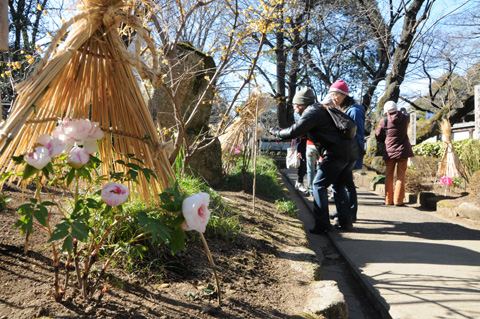
Winter Peonies of the New Year
Peonies of the common spring variety which come to bloom in the low temperatures of winter are known as “winter peonies.” Again this year at the Ueno Toshogu Shrine, beautiful winter peonies, braving the cold of winter, blossomed elegantly under protective straw teepees designed to protect them from snow. Visitors to the shrine could enjoy 600 flowering tree peonies of some 40 different varieties between New Year's Day and the middle of February.
Photo: Winter peonies at Ueno Toshogu Shrine (taken January 31, 2011)
Photo: Winter peonies at Ueno Toshogu Shrine (taken January 31, 2011)
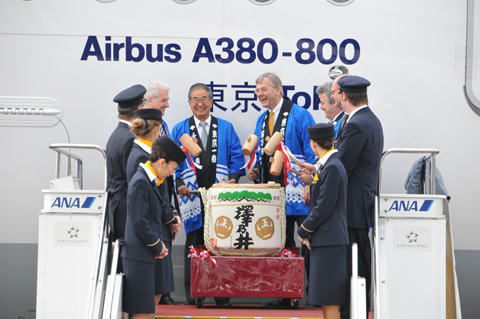
Commemorative event celebrates 50 years of Lufthansa service to Japan
Lufthansa held a commemorative event at Narita International Airport on January 24 in celebration of its 50 years of service to Japan. Festivities included a speech by the organizers, guest speeches, including greetings from Governor Ishihara, a signing ceremony, and a ribbon-cutting ceremony. Following these, an unveiling ceremony, which included breaking open a sake cask, was held for an Airbus A380 which had been christened “Tokyo” and had the name “TOKIO” and the kanji characters for the metropolis painted across its fuselage.
Photo: Narita International Airport (taken January 24, 2011)
Photo: Narita International Airport (taken January 24, 2011)
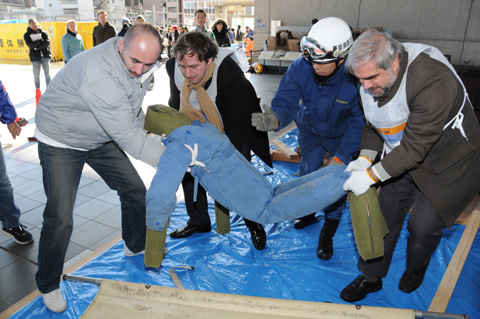
The importance of self-help, cooperation, and working together
On January 18, the Tokyo Metropolitan Government held the Disaster Preparedness Drill for Foreign Residents at the Edo-Tokyo Museum in Sumida Ward. The purpose of the drill was to spread information regarding disaster preparedness among foreign nationals residing in Tokyo, and to also instill in them the necessity of adopting an attitude of cooperation and self-help should an actual disaster strike. Approximately 300 foreign nationals from over 40 countries, including Japanese language school students and staff members from various embassies in Tokyo, gathered for the event. Receiving guidance from the Tokyo Fire Department, participants actively engaged in a variety of hands-on drills and exercises.
Photo: Participants practice rescue techniques
Photo: Participants practice rescue techniques
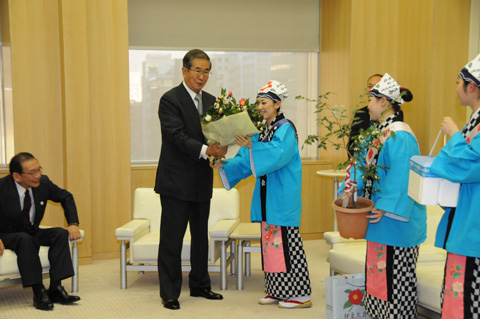
Welcome to Izu Oshima, home to blossoming camellias!
Izu Oshima Island is home to approximately three million naturally blooming common camellia. In order to promote the island's 56th Izu Oshima Camellia Festival, which began January 30, a promotional delegation which included Miss Oshima paid a visit to Governor Ishihara, giving him a bouquet of local flowers and inviting people to visit the island. The Camellia Festival is held throughout the island until March 21.
Photo: Governor Ishihara receiving a bouquet of camellias from Miss Oshima, Eri Tsuiki.
Photo: Governor Ishihara receiving a bouquet of camellias from Miss Oshima, Eri Tsuiki.
February 2011
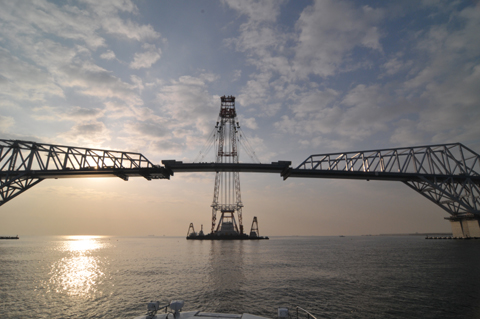
Gate Bridge connected
Starting early morning, February 27, the two sides of the Tokyo Gate Bridge were connected with the installation of the final central girder. When the entire 8-kilometer stretch of the Tokyo Port Seaside Road, including this 2.9-kilometer bridge, is opened to traffic in fiscal 2011, shorter transportation times and mitigation of road congestion in the surrounding area are expected to generate an annual 30 billion yen in economic effects.
Photo: View from a boat in Tokyo Bay (February 27)
Photo: View from a boat in Tokyo Bay (February 27)
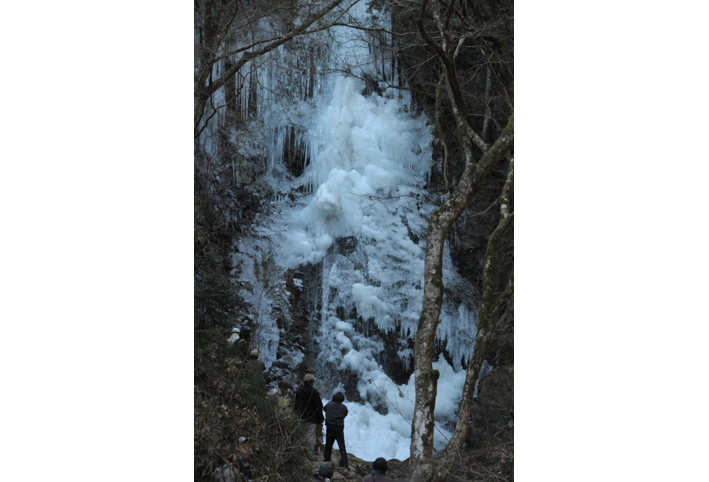
Natural ice art
Eighty-five percent of Hossawa Falls, a waterfall in Hinohara-mura included in Japan's Best 100 Waterfalls, had frozen on January 31. Hossawa Falls has four tiers and a total height of 60 meters. In the peak of winter, the falls often freeze over, presenting a mystical beauty. Many visitors were here today to view this enchanting work of nature.
Photo: Hossawa Falls frozen 85 percent ( February 1)
Photo: Hossawa Falls frozen 85 percent ( February 1)
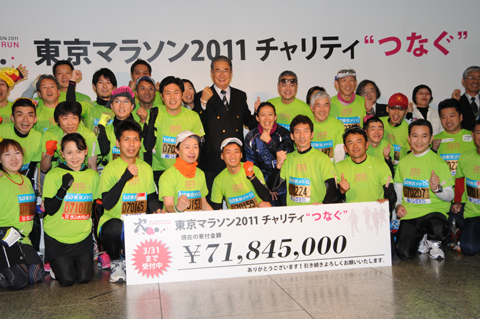
Tokyo Marathon 2011
The Tokyo Marathon was held for the fifth time on February 27, with some 36,000 runners racing through the streets of Tokyo under the clear blue sky. This year, over 71,845,000 yen was raised through a newly introduced charity-runner initiative that allowed those donating over 100,000 yen to run. A portion of the contributions will be donated to relief efforts for the earthquake in New Zealand.
Photo: Governor Ishihara and charity runners pose for a picture (February 27)
Photo: Governor Ishihara and charity runners pose for a picture (February 27)
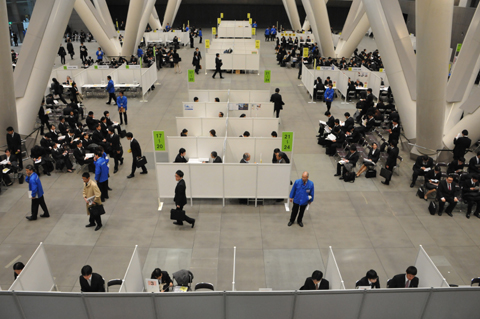
Second joint job fair for prospective college graduates
On February 2 a joint job fair was held at the Tokyo International Forum for the second time since last November. This was organized by the Tokyo Metropolitan Government and the Tokyo Labour Bureau and held for students scheduled to graduate in March who have not yet found a job and recent graduates mainly in their 20s. Morning and afternoon sessions were held with the participation of 186 companies looking to recruit a total of 1,442 people. The 1,640 young people attending the sessions put their best feet forward as they sat through interviews.
Photo: Tokyo International Forum (February 2)
Photo: Tokyo International Forum (February 2)
March 2011
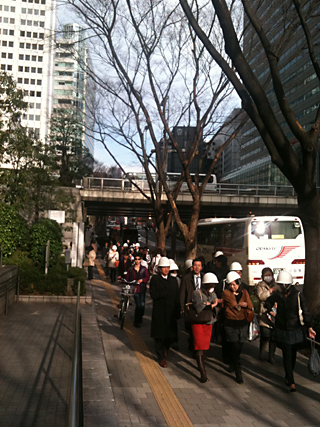
2:46 p.m., March 11
At 2:46 p.m. on March 11, a catastrophic earthquake with a magnitude of 9.0 struck Japan. The Great East Japan Earthquake, with its epicenter off the Sanriku Coast, triggered a devastating tsunami that ravaged the Pacific coast of northeastern Japan. These disasters caused tremendous damage, leading to the Fukushima Daiichi Nuclear Power Plant accident, large-scale power outages, and other problems. With transportation lines disrupted in the Greater Tokyo Area, large numbers of people faced difficulty returning home.
Photo: People evacuating to Shinjuku Central Park immediately after the earthquake (taken at 3:36 p.m., March 11)
Photo: People evacuating to Shinjuku Central Park immediately after the earthquake (taken at 3:36 p.m., March 11)
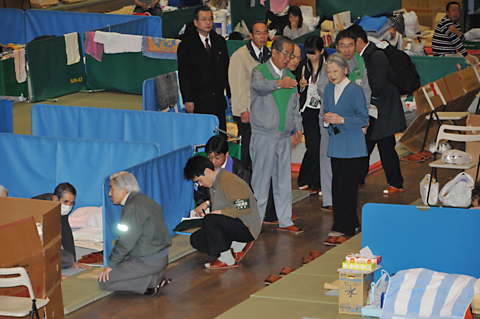
Their Majesties the Emperor and Empress visit an evacuation shelter
On March 30, Their Majesties the Emperor and Empress paid a visit to Tokyo Budoh-kan in Adachi Ward to console the people who had evacuated to Tokyo after the Great East Japan Earthquake. Over the course of 40 minutes, they met and exchanged warm words with each and every evacuee. Tokyo also sheltered evacuees at the Ajinomoto Stadium and Tokyo Big Sight.
Photo: Their Majesties speaking with evacuees (March 30)
Photo: Their Majesties speaking with evacuees (March 30)
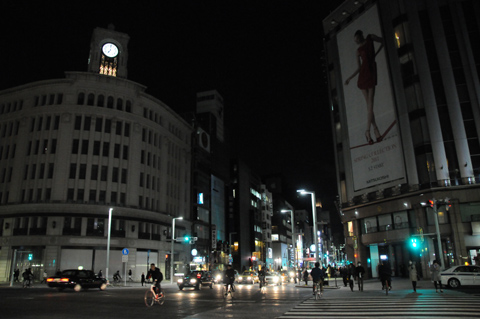
Neon lights gone from Ginza
Tokyo was struck by power shortages following the Great East Japan Earthquake. On March 16, shortly after 6 p.m., almost all the stores lining Ginza Chuo-dori Avenue, one of Tokyo’s main shopping streets, had lowered their shutters, closing shop to save power. Even the ubiquitous neon lights were turned off in this “city that never sleeps.” In the darkness, bicycles rushing home and empty taxis had transformed the symbolic Ginza 4-chome intersection.
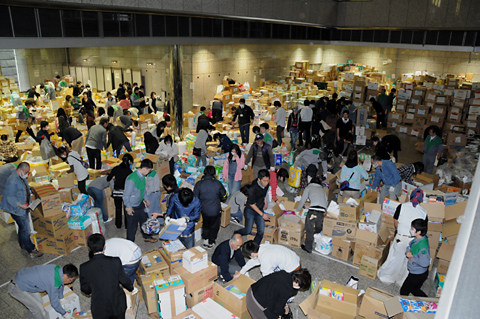
floor buried in relief supplies
On March 22, the first floor of the Tokyo Metropolitan Government Building was buried in relief supplies donated by civilians. The Tokyo Metropolitan Government had been accepting relief goods to be sent to the areas affected by the Great East Japan Earthquake. Items brought directly to the TMG Building between March 18 and 23 filled some 15,000 cardboard boxes.
Photo: Several hundred TMG personnel and civilian volunteers sort supplies into boxes
Photo: Several hundred TMG personnel and civilian volunteers sort supplies into boxes
April 2011
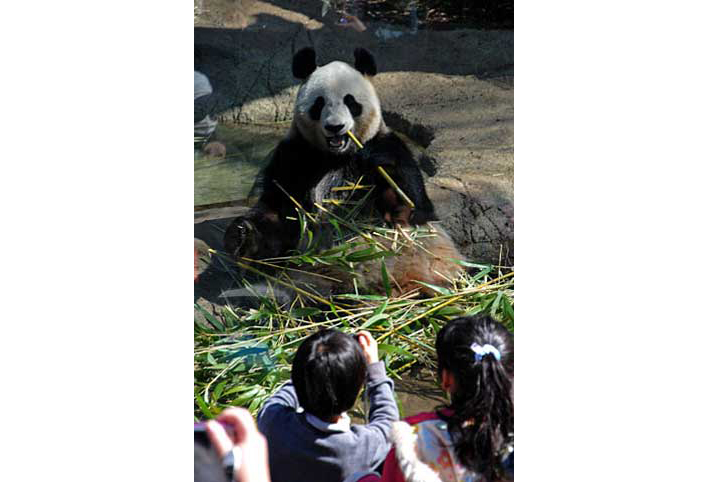
Giant panda exhibit opens to public
Two giant pandas that arrived from China in February, Ri Ri (male) and Shin Shin (female), were put on public display at the Ueno Zoological Gardens on April 1. With cherry blossoms starting to bloom in Ueno Park, a long line of people hoping to catch a glimpse of the pandas formed in front of the zoo's entrance on the first day of the exhibit. The last time the zoo had pandas available for public viewing was three years ago in 2008.
Photo: Female giant panda Shin Shin (April 1)
Photo: Female giant panda Shin Shin (April 1)
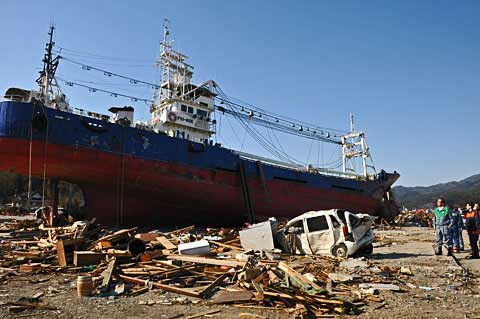
Governor Ishihara visits disaster-stricken Kesennuma
On April 5, Tokyo Governor Shintaro Ishihara paid a courtesy call on Yoshihiro Murai, the Governor of Miyagi, whose prefecture was severely damaged in the Great East Japan Earthquake. He later visited affected areas in Kesennuma, where he extended words of encouragement to TMG staff sent there to conduct restoration and reconstruction activities. In Kesennuma, the tsunami triggered by the quake destroyed many buildings, washed large and small boats inland, and also caused major fires. A considerable number of the area's residents perished or remain missing.
Photo: Governor Ishihara looks up at a boat that was washed inland by the tsunami (April 5)
Photo: Governor Ishihara looks up at a boat that was washed inland by the tsunami (April 5)
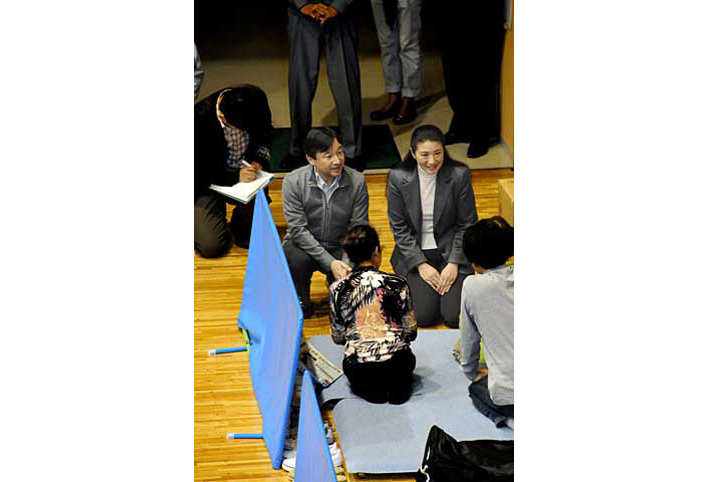
Their Imperial Highnesses the Crown Prince and Crown Princess visit evacuation shelter
On April 6, their Imperial Highnesses the Crown Prince and Crown Princess visited Ajinomoto Stadium in Chofu City, Tokyo, where they met with evacuees from Fukushima Prefecture and other areas affected by the Great East Japan Earthquake. Approximately 130 people are temporarily living in the stadium's gymnasium and meeting rooms. Their Imperial Highnesses visit went over schedule as they spoke to a large number of disaster victims and listened intently to their stories.
Photo: Their Imperial Highnesses the Crown Prince and Crown Princess talking with disaster victims
Photo: Their Imperial Highnesses the Crown Prince and Crown Princess talking with disaster victims
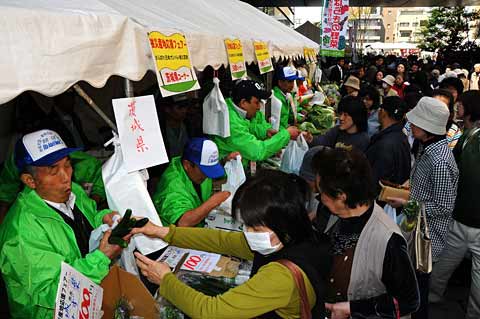
Dispel harmful rumors!
On April 13, producers from five prefectures (Fukushima, Ibaraki, Tochigi, Gunma, and Chiba) affected by harmful rumors resulting from the accident at the Fukushima Daiichi Nuclear Power Plant, held a fair to support the afflicted producers in front of Adachi Ward Office. The event was held in collaboration with the Tokyo Metropolitan Central Wholesale Market to promote the safety of agricultural products from the abovementioned prefectures. The event attracted approximately 3,000 visitors and, with goods priced about 30 to 40 percent cheaper than normal, almost all products were sold out one and a half hours after the event's opening, making for a great success.
May 2011
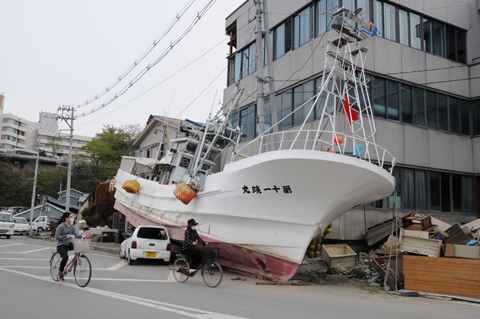
A visit to areas stricken by the Great East Japan Earthquake
In Kesennuma City, Miyagi Prefecture, a fishing boat washed up by the tsunami sits stranded on the road. Scenes like this are not uncommon throughout the city. Two women on bicycles pass, wearing masks against dust generated by the disaster.
(Photo taken May 9)
(Photo taken May 9)
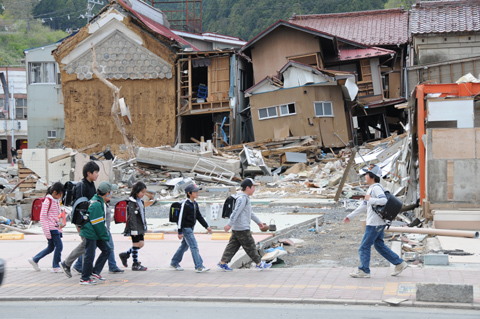
A visit to areas stricken by the Great East Japan Earthquake
Classes resume in Kesennuma City, with the reopening of schools close to two months after the disaster. The laughs of cheery children can be heard resonating through the devastated town.
(Photo taken May 9)
(Photo taken May 9)
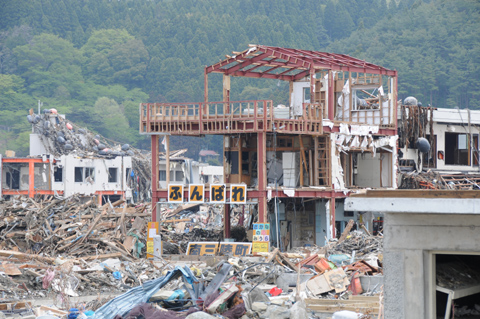
A visit to areas stricken by the Great East Japan Earthquake
Foundations are all that remain of wooden buildings built near the harbor in Minamisanriku Town, Miyagi Prefecture; while the steel frame of the fishmonger's store and home narrowly managed to escape being washed away. Along with a sign that reads "Hold strong, Minamisanriku Town," is a notice that all members of the family are safe.
(Photo taken May 11)
(Photo taken May 11)
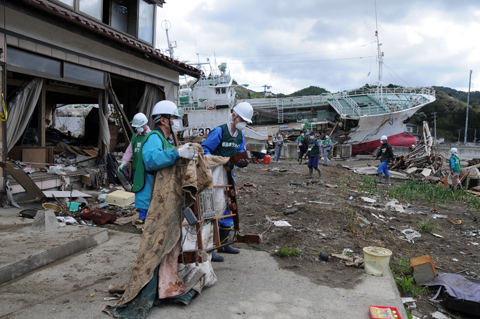
A visit to areas stricken by the Great East Japan Earthquake
Even this house in Kesennuma City located one kilometer from the coast was hit by the tsunami. A large boat washed up from the harbor sits next to it. "Tokyo Volunteers," recruited and dispatched by the Tokyo Metropolitan Government, work selflessly to make a difference.
(Photo taken May 10)
(May 26, 2013)
(Photo taken May 10)
(May 26, 2013)
June 2011
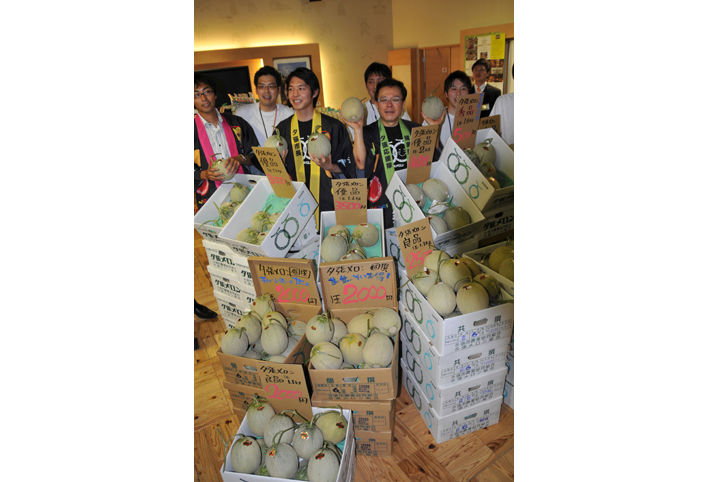
Event at TMG features Yubari
As one facet of cooperation between Yubari city and Tokyo, the opening ceremony of the Yubari event at the Japanese Prefectural Tourism Promotion Center on the second floor of the Tokyo Metropolitan Government No. 1 Building was held on June 15. Following the opening address by Yubari Mayor Suzuki and a taiko drum performance by the Yubari Taiko Preservation Society, local Yubari specialties and mascot goods were put on sale.
Photo: Yubari Mayor Suzuki, Vice Governor Inose, and young TMG officials who attended a training session in Yubari help sell Yubari melons, the local specialty
Photo: Yubari Mayor Suzuki, Vice Governor Inose, and young TMG officials who attended a training session in Yubari help sell Yubari melons, the local specialty
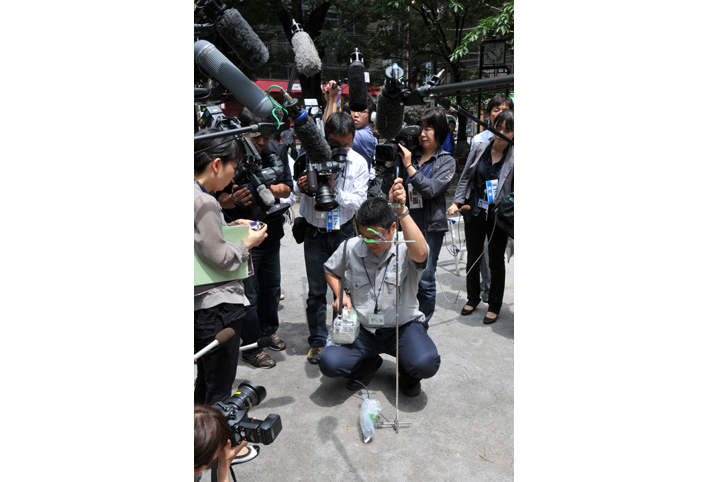
Measuring airborne radiation levels in Tokyo
Tokyo expanded its survey of airborne radiation levels to take measurements throughout the metropolitan area (approximately 100 locations). The first measurement was taken at Hinodecho Park in Toshima Ward, where many members of the press looked on as a metropolitan government official measured radiation levels at both five centimeters and one meter off the ground.
Photo: The media watches as a metropolitan government official takes measurements (June 15)
Photo: The media watches as a metropolitan government official takes measurements (June 15)
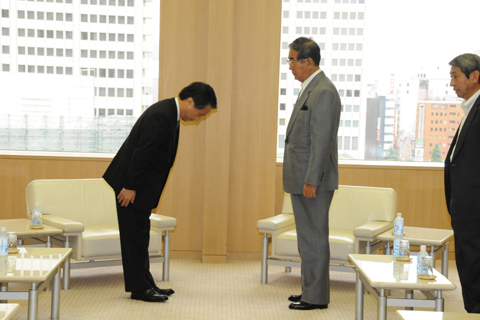
President of JR East apologizes to Governor Ishihara
East Japan Railway Company President Seino visited Governor Ishihara at the metropolitan government office on June 20 to apologize for their lack of consideration toward passengers when they shuttered stations in the immediate wake of the March 11 Great East Japan Earthquake and other inconveniences that followed. Governor Ishihara maintained a stern expression throughout the meeting, responding that JR East should have apologized to Tokyo residents and passengers earlier.
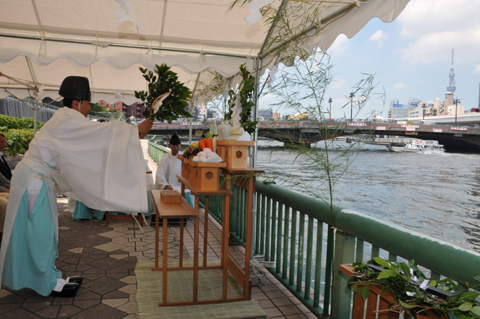
River opening ceremony revived in Ryogoku
On June 29, supporters from the Sumidagawa River Basin Water Transport Tourism Association revived the Ryogoku Kawabiraki, or ceremony for the opening of the boating season, at Ryogokubashi Nishizume located at the foot of Ryogokubashi bridge on the right bank of the Sumidagawa River. The ceremony is believed to have its beginnings in a water god festival held by the eighth Tokugawa shogun, Tokugawa Yoshimune, to pray for the spirits of those who died from famine and plague. The fireworks following the festival were a popular summer attraction in the Edo period and are believed to be the origins of the present day Sumida River Fireworks Festival.
Photo: Prayer for safety by a Kanda Myoujin Shrine priest (June 29)
Photo: Prayer for safety by a Kanda Myoujin Shrine priest (June 29)
July 2011
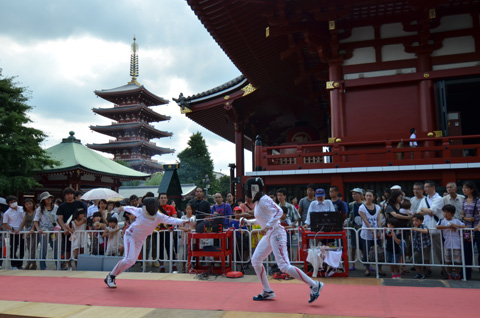
Tokyo Sports Town 2011
On July 30, the Tokyo Metropolitan Government held Tokyo Sports Town 2011, a large-scale event that allows visitors to try their hand at various sports in the center of Tokyo. This year's event took place inside Sensoji Temple in Asakusa. Special areas were set up for the horizontal bar, balance beam, floor exercises, track and field, trampoline, fencing, blind soccer, kabaddi, and climbing, with top-level athletes putting on demonstrations for the crowd to see.
Children were also able to try the various events and test their skills against the athletes, providing them the chance to experience the fun of sports under the coaching of top athletes.
Photo: Demonstration by a fencer (July 30)
Photo: Demonstration by a fencer (July 30)
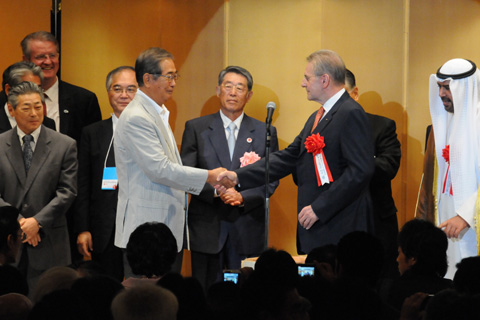
Tokyo to bid again for the Olympics
On July 16, the Tokyo Metropolitan Government announced its intention to bid for the 2020 Olympic and Paralympic Games. Governor Ishihara delivered a speech at a reception held at a Tokyo hotel celebrating the 100th anniversary of the establishment of the Japan Sports Association and the Japanese Olympic Committee. In his speech, the Governor spoke passionately about making "reconstruction" the theme for the Olympics, with the aim to show the world Japan's recovery from the Great East Japan Earthquake.
Photo: Governor Ishihara shaking hands with IOC President Jacques Rogge (right) after officially announcing Tokyo's bid for the Olympics
Photo: Governor Ishihara shaking hands with IOC President Jacques Rogge (right) after officially announcing Tokyo's bid for the Olympics
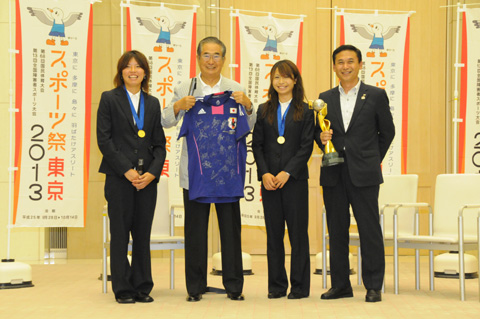
Nadeshiko Japan calls on Governor
On July 20, the head coach and players of Nadeshiko Japan, which achieved a historic victory in the FIFA Women's World Cup in Germany after defeating the United States in the finals, paid a courtesy call on Governor Ishihara. The Governor thanked the players as he shook their hands one by one, commenting, "You really did a good job. Thank you. " After a pleasant chat, the players presented the Governor with a uniform with all of their signatures.
Photo: (From left) Saki Kumagai, Governor Ishihara, Aya Sameshima, and Head Coach Norio Sasaki
Photo: (From left) Saki Kumagai, Governor Ishihara, Aya Sameshima, and Head Coach Norio Sasaki
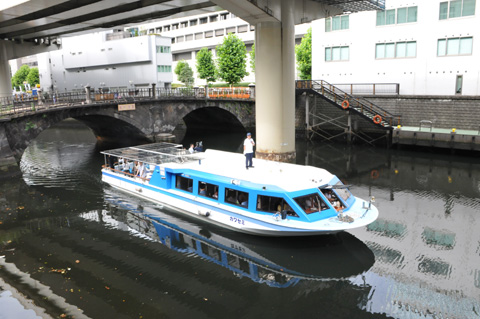
Water bus "Kawasemi" launches services
Water bus "Kawasemi" commenced services from July 22 under the catchphrase, "Touring Rivers, Touring Bridges." Traditionally, water buses operate on major rivers such as Sumidagawa and Arakawa, but the Kawasemi has undergone renovations to achieve a more compact size and lower roof so that it can navigate the Onagigawa, Nihonbashigawa, and other narrow rivers, and also pass under bridges. The concept for the Kawasemi's services is "Newly Discover Edo-Tokyo."
Photo: Kawasemi passes under Tokiwabashi Bridge (July 7)
Photo: Kawasemi passes under Tokiwabashi Bridge (July 7)
August 2011
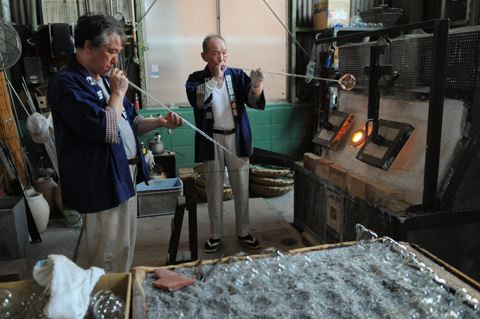
Father and son make wind chimes to beat the heat
The intense heat of summer signals high season for Shinohara Furin located in Minami Shinozaki, Edogawa Ward. August 12 recorded a scorching 30°C, but it easily exceeds 50°C where Yoshiharu Shinohara, an Honorary Citizen of Tokyo, and his son, Hiroshi, stand in front of a furnace that holds a crucible embedded in burning coke. From the crucible, they wind molten glass that looks like orange candy around a blow pipe and blow air inside. It appears more an ascetic practice than a craftsman's work. Father and son make some 500 wind chimes a day.
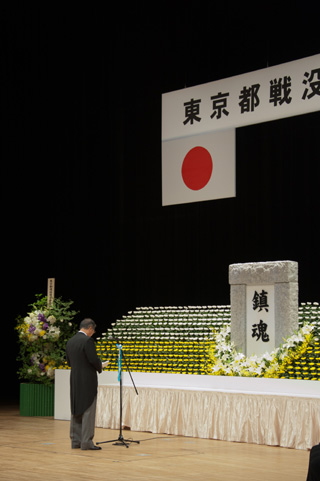
Tokyo Memorial Service for the War Dead
The Tokyo Memorial Service for the War Dead was held at the Bunkyo Civic Hall on August 15, the anniversary of the end of the war. Some 1,000 participants, including surviving families from the Tokyo area, assembled for the memorial service, and as the clock struck noon offered a silent prayer to the Tokyo residents who lost their lives.
Photo: Governor Ishihara delivering his address (August 15)
Photo: Governor Ishihara delivering his address (August 15)
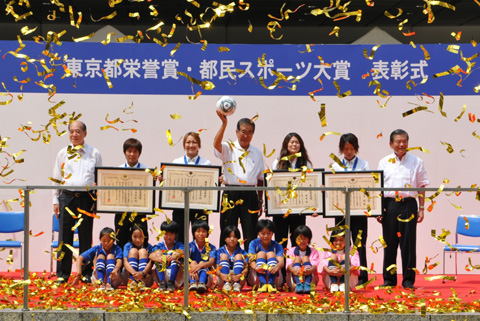
"Tokyo Medal of Honor and Tokyo Residents Sports Award" ceremony
The Tokyo Medal of Honor and Tokyo Residents Sports Award" ceremony was held at the Tomin Hiroba (Citizens' Plaza) on August 17. Homare Sawa, Azusa Iwashimizu, Karina Maruyama, and Mana Iwabuchi from Nadeshiko Japan, Japan women's national football team, were conferred awards. Under the watch of 2,300 people, Governor Ishihara presented them with certificates and Homare Sawa expressed their resolve to win the gold medal at the London Olympics.
Photo: Celebrated with a shower of golden confetti (August 17)
Photo: Celebrated with a shower of golden confetti (August 17)
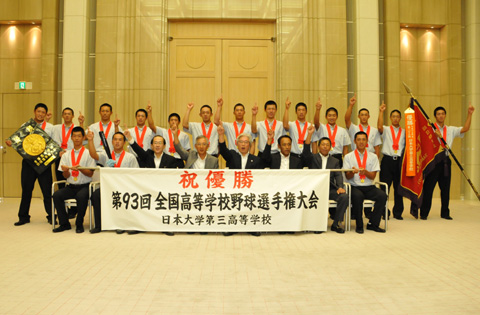
The Third High School of Nihon University announces victory
On August 25, athletes from the Third Senior High School of Nihon University, the West Tokyo representative who secured their second win in 10 years at the 93rd National High School Baseball Championship, visited the metropolitan government to report on their victory. They expressed their appreciation saying, "the cheers of the residents of Tokyo were of enormous support." In commemoration, Vice Governor Sato presented Vice Captain Suzuki with a bat signed by Governor Ishihara.
Photo: "No. 1!" Athletes from the Third High School of Nihon University relish their victory (August 25)
Photo: "No. 1!" Athletes from the Third High School of Nihon University relish their victory (August 25)
September 2011
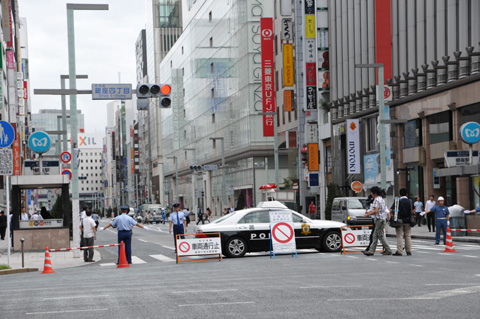
Large-scale traffic restrictions implemented in disaster drill
Under a scenario of an earthquake directly hitting Tokyo, the Metropolitan Police Department (MPD) conducted a large-scale drill on September 1, Disaster Preparedness Day, which stopped traffic at approximately 100 locations along major streets in the capital. In response to the traffic congestion following the Great East Japan Earthquake, which made passage difficult for emergency vehicles, the MPD closed off roads into central Tokyo for around 10 minutes to ascertain whether any problems would arise.
Photo: The Ginza 4-chome intersection (September 1)
Photo: The Ginza 4-chome intersection (September 1)
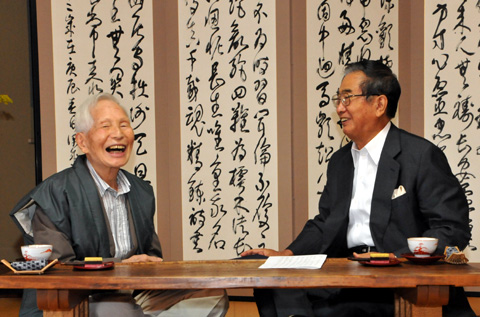
Celebrating 100 years
With Respect-for-the-Aged Day coming soon, Governor Ishihara visited the home of Ota Ward-resident Katsunori Kishida on September 7. After retiring from his position as a middle-school principal, Mr. Kishida became a calligraphy instructor, teaching at a university as well as to neighborhood children. Governor Ishihara presented him with a letter of congratulations and a Murayama Oshima silk hanten (a traditional short coat), and the two enjoyed a friendly discussion about calligraphy and Chinese poetry. There are 2,105 people in Tokyo who will be turning 100 years old this fiscal year, 130 more than last year.
Photo: Governor Ishihara with Mr. Katsunori Kishida (September 7)
Photo: Governor Ishihara with Mr. Katsunori Kishida (September 7)
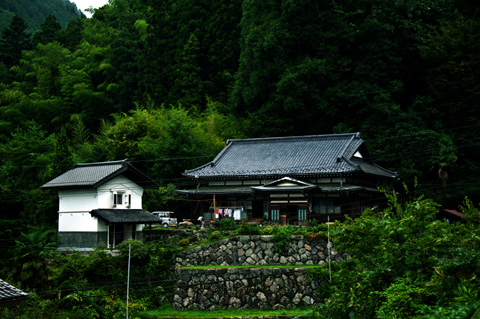
The storehouses of Hinode Town, Tokyo
Hinode Town was struck by a major fire known as the "Okunoyake" in 1882, reducing most of the town to ashes, including its shrines and temples, but leaving the storehouses. This reawakened awareness of the fire-resistance of storehouses. Following this, the many farms that had grown wealthy from their work in forestry and sericulture began building storehouses as well. Currently, 157 storehouses lend color to the mountain-village landscape.
Photo: In Hinode Town (September 5)
Photo: In Hinode Town (September 5)
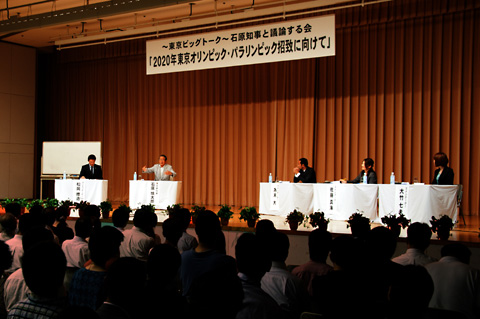
Tokyo's bid for the 2020 Olympics
On September 13, the Tokyo Metropolitan Government held its "Tokyo Big Talk", a meeting to talk with Governor Ishihara. The meeting's theme was "Tokyo's Bid for the 2020 Tokyo Olympic and Paralympic Games".
Participating on this day were Governor Ishihara and four athletes who have participated in the Olympic and Paralympic Games and other world competitions. With professional tennis player Shuzo Matsuoka doing an excellent job in conducting the proceedings as well, lively discussions were held at this meeting attended by some 460 Tokyo residents.
October 2011
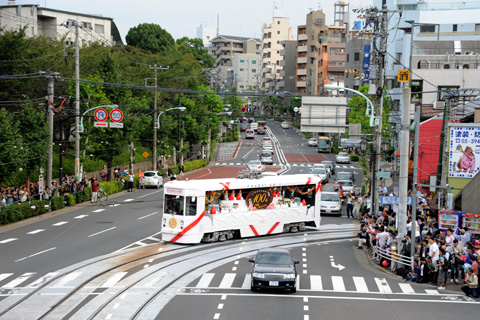
"Hana Densha" celebrates Toei Transportation centennial
In commemoration of its 100th anniversary, Toei Transportation operated a specially decorated streetcar, "Hana Densha", on the Toden Arakawa Line. This was the first time in 33 years since the event celebrating the conversion to conductor-less operations of the Arakawa Line that such a decorated car was used. Along with railroad aficionados, many Tokyo residents lined the streets to see the car decorated like a birthday cake.
Photo: The "Hana Densha" passing through the Asukayama intersection (October 1)
Photo: The "Hana Densha" passing through the Asukayama intersection (October 1)
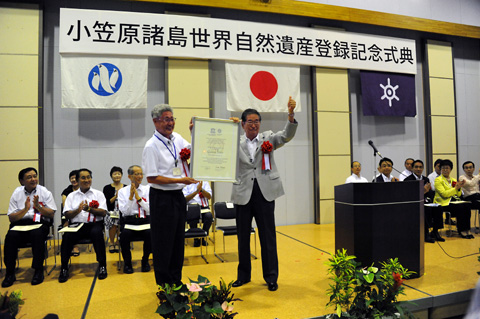
Ceremony for Ogasawara Islands' World Heritage listing
UNESCO's World Heritage Committee designated the Ogasawara Islands for inscription on the World Heritage List this June. The Tokyo Metropolitan Government held the commemoration ceremony on Chichijima, an island in the chain. The inscription certificate was displayed at the ceremony, with the occasion celebrated by all the participants.
Photo: Governor Ishihara and Ogasawara Mayor Morishita holding site inscription certificate (October 14)
Photo: Governor Ishihara and Ogasawara Mayor Morishita holding site inscription certificate (October 14)

Comprehensive Disaster Management Drill at Harumi
The annual Comprehensive Disaster Management Drill was jointly held this year by the Tokyo Metropolitan Government and the cities of Kodaira, Nishitokyo, Musashino, and Koganei on October 29. Based on lessons learned from the Great East Japan Earthquake, in addition to conventional drills, drills with the details undisclosed to the participants were held this year. In order to bolster tsunami preparedness in the Tokyo Bay area, new drills were implemented to close movable floodwall gates and guide residents to safety.
Photo: Closing a movable floodwall gate (October 29)
Photo: Closing a movable floodwall gate (October 29)
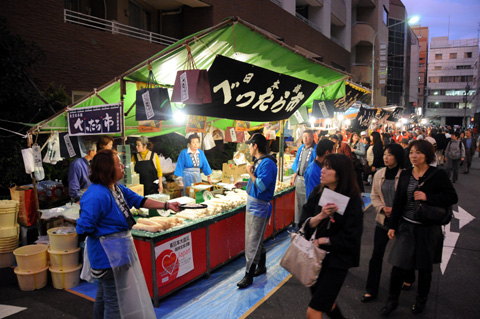
The bustling Bettara Fair
The Bettara Fair (bettara is pickled daikon radish) dates back to the 18th century. It started with the sales of fish and vegetables in front of the Takarada Ebisu Shrine in today's Nihonbashi-honcho, Chuo Ward. Sold for offering at the Ebisu Festival, one of the wares on sale was bettara-zuke. This name for daikon radish pickled in the malt of sweet fermented rice wine, comes from "betobeto", the expression for "sticky". Held from October 19 to 20 again this year, the fair was a bustling success, with many street stalls participating.
Photo: Vendors call out heartily to passersby to try out their bettara-zuke
Photo: Vendors call out heartily to passersby to try out their bettara-zuke
November 2011

Waiting to open for business, Tokyo Sky Tree
Standing 634 meters in height, the full scale of Tokyo Sky Tree is revealed as the tower awaits its May 22, 2012, opening.
Commanding a view of the Sumidagawa River flowing below, Tokyo Sky Tree rises majestically into the sky. Recognized by Guinness World Records as the world's tallest tower, Sky Tree is sure to be the new addition to Tokyo's popular sightseeing spots.
Photo: Aerial view of Tokyo Sky Tree (November 16)
Photo: Aerial view of Tokyo Sky Tree (November 16)
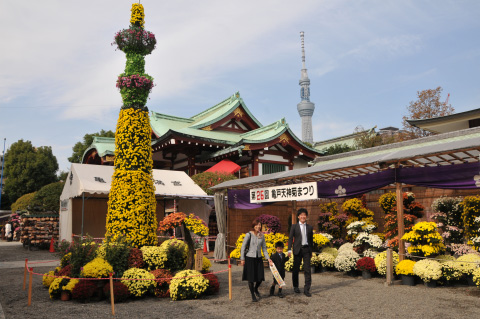
Chrysanthemum Festival at the Kameido Tenjin Shrine
This year saw the Kameido Tenjin Shrine in Koto Ward hold its Chrysanthemum Festival (Kiku Matsuri) for the 26th time. Visitors came out in great numbers to enjoy the over 500 pots of vibrantly colored chrysanthemums on display. A chrysanthemum sculpture made in the shape of Tokyo Sky Tree stood in contrast to the real tower soaring in the background, and was truly a sight to see. The flowers also added color to commemorative photos taken by families visiting the shrine for shichi-go-san, a rite for children aged three, five, and seven in which thanks and prayers are offered to the gods for health and well-being.
Photo: Chrysanthemum Sky Tree and the real Tokyo Sky Tree in the background (November 15)
Photo: Chrysanthemum Sky Tree and the real Tokyo Sky Tree in the background (November 15)
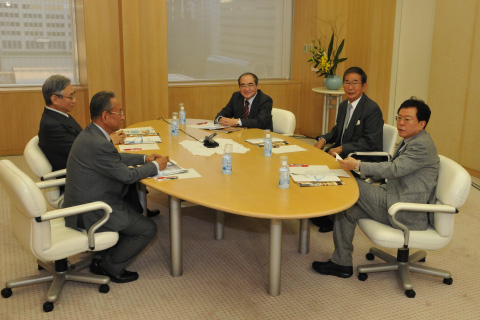
Educational Renaissance: Tokyo Round Table Conference held
The 1st Tokyo Round Table Conference was held on November 16 at the Tokyo Metropolitan Government Building. The conference, comprising the governor and experts from various fields, is a platform for multifaceted discussions on the direction of Japan's educational system. Governor Ishihara, Vice Governor Inose, Yoshiyuki Kasai (vice board chairman of Kaiyo Academy and chairman of the Central Japan Railway Company), Mineo Nakajima (Akita International University president and chair of the board of trustees), and Fumio Harashima (Tokyo Metropolitan University president) participated in the round table, exchanging ideas from a wide range of perspectives.
Photo: The 1st Tokyo Round Table Conference (November 16)
Photo: The 1st Tokyo Round Table Conference (November 16)
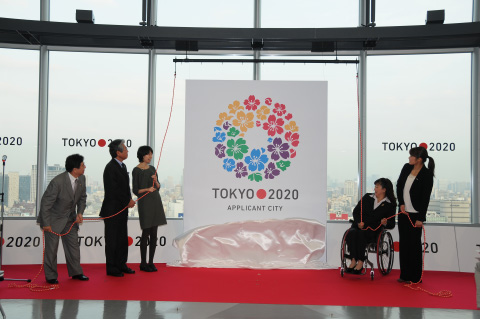
Tokyo unveils bid logo for 2020 Olympic and Paralympic Games
The Tokyo 2020 Bid Committee unveiled the logo for its bid on November 30. Selected through a design competition, the winning submission by Ai Shimamine, a fourth-year student at the Joshibi University of Art and Design, is a wreath-shaped arrangement of cherry blossoms, the symbolic flower of Japan. The wreath also symbolizes "coming back again" ?the Olympic and Paralympic Games coming back to Tokyo, and Japan coming back from the March 11 earthquake ?reflecting a strong desire to bring courage and vitality back to Japan through sports.
Photo: Ai Shimamine (third from the left), the creator of the logo, and others (November 30)
Photo: Ai Shimamine (third from the left), the creator of the logo, and others (November 30)
December 2011

Sports Festival Tokyo 2013 Mascot Dance Unveiled
The Sports Festival Tokyo 2013 Executive Committee held an unveiling ceremony for its mascot Yuriito's song and dance, "Yuriito Dance: Smile and Do Your Best!" The lyrics, music, and choreography were produced by the popular artist Miwako “Peco” Hamada, well known for her choreography for the popular television series theme song, "Maru Maru Mori Mori!" A large audience enjoyed watching Yuriito and the Yuriito Kids sing and dance.
Photo: Tachikawa Station concourse (December 27)
Photo: Tachikawa Station concourse (December 27)
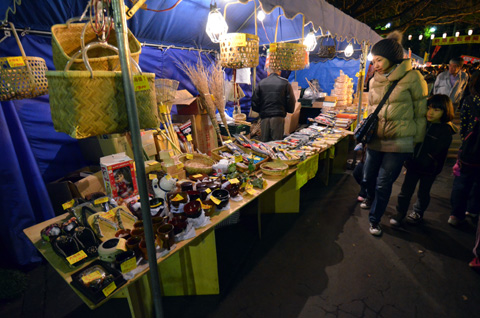
The Seki no Boro-ichi Fair
Some 300 stalls gathered for the Seki no Boro-ichi Fair, held every December 9 and 10 in conjunction with the oeshiki ceremony commemorating Nichiren (the founder of Nichiren Buddhism) at the Musashiseki Honryuji Temple. Designated as one of Nerima ward's intangible folk cultural properties, the Boro-ichi Fair has been held continuously since the mid-18th century. It is said to have originated as a market for the sale of agricultural tools and old fabric scraps (boro). While most stalls now sell food, the few vendors still offering brooms, sickles, old clothing, and traditional tabi socks transport us back to the fair's early days.
Photo: The Seki no Boro-ichi Fair (December 9)
Photo: The Seki no Boro-ichi Fair (December 9)
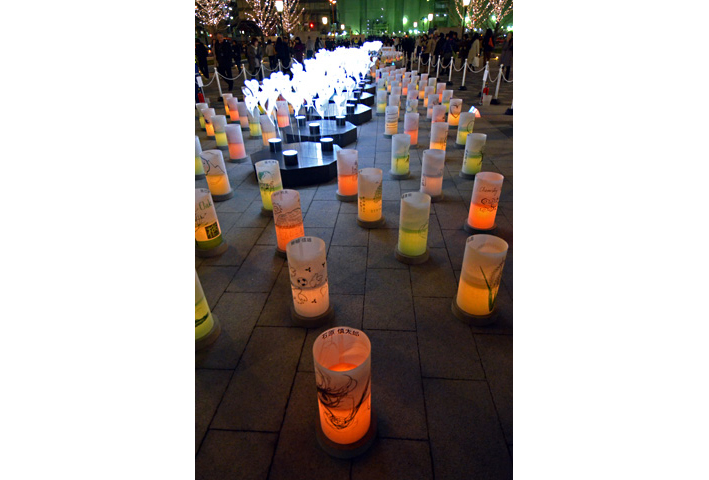
Lightopia 2011
Lightopia 2011, a festival of lights based on the core themes of earth, the environment, and peace, took place in the Otemachi, Marunouchi, and Yurakucho district of Chiyoda ward. The event had two main attractions: Flower Fantasia, in which roadside trees and flower beds glittered with decorative lights; and Ambient Candle Park, an area where "future flowers" and lanterns adorned with pictures carried the message of "hopes and bonds for the future," praying for recovery from the Great East Japan Earthquake. Elementary school children from the disaster-affected areas and prominent members of society, including Nadeshiko Japan, had decorated the lanterns with messages and illustrations.
Photo: "Future flowers" and lanterns adorned with pictures (December 28)
Photo: "Future flowers" and lanterns adorned with pictures (December 28)

Recovery Support Festival Held in Tokyo
In order to support the recovery and economic revitalization of Iwate, Miyagi, and Fukushima prefectures, the Tokyo Metropolitan Government hosted a festival at the Tokyo International Forum from December 19 to 21. Local specialties and crafts from the three prefectures were available for purchase. Additionally, dynamic Morioka Sansa Odori dancing and a Fukushima Hawaiian Show were performed on a special stage, delighting some 24,000 visitors who came out to enjoy the festivities.
Photo: Visitors crowd the festival venue (December 19)
Photo: Visitors crowd the festival venue (December 19)